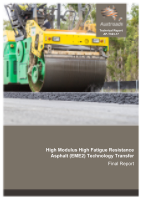Pavement

- Publication no: AP-T323-17
- ISBN: 978-1-925451-88-7
- Published: 11 July 2017
- PDF (free) Download
EME2 mixes are produced using a hard paving grade bitumen applied at a high binder content (approximately 6%). Compared to conventional asphalt bases with unmodified binders, EME2 asphalt is characterised by high stiffness, high durability, superior resistance to permanent deformation and good fatigue resistance. International and Australian experience indicates that significant pavement thickness reductions can be achieved using EME2.
The purpose of this project was to assist industry in the successful transfer of French Enrobés à Module Elevé Class 2 (EME2) technology to Australia. EME2 technology offers the prospect of reduced asphalt thicknesses for heavy duty pavements, and lower construction and maintenance costs. TT1908 was a three-year Austroads project, and this report summarises the outcomes of the final year of the study.
As part of the project, an Australian specification framework for EME2 mixes was developed and the requirements for manufacturing, paving and compliance were also provided. Demonstration trials were also carried out as part of the validation process.
The final EME2 mix design specification limits are provided and discussed in this report.
Note: the EME2 report reflects the tonnes of EME2 laid as at December 2016 (8,000 tonnes). Since then road projects in Brisbane, the Gold Coast and Perth have utilised the technology. By July 2017 more than 28,000 tonnes of EME2 have been laid in Australia.
- Summary
- 1. Introduction
- 1.1. Background
- 1.2. Objectives
- 1.3. Scope
- 1.4. Structure of the Report
- 2. Development of EME2 Specification Limits
- 2.1. Interim Specification Limits
- 2.2. Development of Final EME2 Performance Specifications
- 2.2.1. Workability
- 2.2.2. Moisture Sensitivity
- 2.2.3. Rut Resistance
- 2.2.4. Flexural Modulus
- 2.2.5. Fatigue
- 2.2.6. Final Specification Limits
- 3. Victorian Trial
- 3.1. Objectives of the Victorian EME2 Trial
- 3.1.1. Trial Delivery
- 3.2. Design of the Trial
- 3.2.1. EME2 Mix Design
- 3.2.2. EME2 Pavement Design
- 3.2.3. Construction
- 3.2.4. Production Control and In Situ Density Testing
- 3.2.5. Temperature Monitoring
- 3.2.6. Weather Station Installation
- 3.3. Post-construction Testing
- 3.3.1. Extraction of Cores
- 3.3.2. Testing of Extracted Cores
- 3.4. Performance Monitoring
- 3.5. Discussion
- 3.5.1. In Situ Density
- 3.5.2. Resilient Modulus at Standard 25 C Temperature
- 3.5.3. Resilient Modulus vs. Temperature
- 3.5.4. Setting a Minimum Paving Temperature for EME2
- 4. Queensland Trial
- 4.1. Supplementary Laboratory Testing
- 4.1.1. Resilient Modulus
- 4.1.2. Air Voids – Mensuration vs. SSD
- 4.1.3. Flexural Stiffness Testing
- 5. Implementation to Date
- 6. Conclusions and Findings
- 6.1. Conclusions
- 6.2. Findings
- References
- Appendix A Construction Site Victorian EME2 Demonstration Trial
- Appendix B In Situ Bulk Density and Air Voids Results
- Appendix C Resilient Modulus Test Results
- Appendix D Resilient Modulus Corrected to 5% Air Voids
